Roguelikes are notoriously difficult. In this way they’re really no different from games of old, across numerous genres, which many players were far from guaranteed of completing. It’s only today that roguelikes have become more uniquely associated with difficulty because the market around them has changed so much!
There will always be an additional layer of inherent challenge to a game with content that changes from play to play, but while traditional roguelikes and their players continue to embrace that challenge, the wider games market has shifted along with player expectations. In short, as gaming has exploded to include a much larger group of consumers, consumers with different needs and capabilities, developers have sought to take those circumstances into account. (There is even a portion of players that believe they deserve access to every part of a game, as content they paid for!) Therefore these days it’s common practice for games to include multiple difficulty levels, with pressure to embrace such options as just another form of accessibility. This is especially true with respect to commercial games, which are reliant on sales to survive--more accessible games simply means more sales!
Being free, and niche, roguelikes have always been somewhat insulated from this trend--very few offer difficulty settings, not to mention the nature of their design and common mechanics (e.g. permadeath) make following that trend somewhat less meaningful. In some ways the point of a roguelike is to offer as many challenges as possible, and as long as it is theoretically possible to overcome those challenges then no one’s to complain, right?
That said, it’s probably not a coincidence that two widely popular roguelikes also offer multiple difficulties.
Tales of Maj’Eyal has five separate difficulty settings, one below normal and three above. From the creator, DarkGod:
“Difficulties were first added like six years ago or so. As for why, well first because I can! I made the engine robust enough that I can do them very easily. And most importantly because not all players have the same skill. I for once barely manage to win on normal with my preferred class while others find normal to be braindead. My goal has always been to give fun to as many people as possible and that follows along. Also to note that my difficulty levels are not simple number bumps (there are those too obviously), each level introduces new harder mechanics (like random bosses, being constantly hunted, …). To be fair I do not understand why devs do NOT put difficulty levels in their games heh ;)”
DoomRL also has five separate settings, distributed in the same way. From the creator, Kornel Kisielewicz:
“It raises the replayability of the game, allowing you to go more difficult once you feel that the game is getting to easy. Initially it was added just as a tribute to Doom, but it turned out to be a great feature, so I gave it a lot more thought later on.”
Interestingly, both developers emphasize settings as a way to increase the challenge level, an approach also reflected by the available options, wherein the default is towards the lower end of the scale.
ADOM also added more gameplay settings in recent years, some of which have an effect on difficulty.
Whether or not to implement difficulty levels, and the best approach to take, comes down to a question of who we’re balancing the game for, and what do we hope those players can experience? As a hardcore fan of roguelikes, I’ve always enjoyed that winning is not inevitable for everyone, even given years of play and practice. The thrill and excitement at each new degree of personal achievement has always felt like an integral part of the roguelike experience, and if “content” is attainable without a high level of skill then that experience is watered down.
Outside the roguelike realm I’ve noticed a trend of games stating up front that they are very challenging and aimed at the hardcore audience, which at least puts players in the right mindset from the beginning, asking themselves “hm, it’s meant to be hard--can I take this challenge?” before even starting. This trend became most apparent following the success of Dark Souls, interesting because the same mindset used to be simply assumed back when gaming was more niche: If you weren’t good enough, you may very well not see the whole game. That is certainly one option, to just make it clear that “the game is tough, good luck!” I would argue that if areas of the game most players can generally reach are still fun (and they should be!) and fully satisfying (that one’s a bit harder…) that’s the most important part, but times have changed. And expectations with them.
I’ve softened my own position on the matter as well, especially in the 21 months since releasing the first Cogmind alpha and listening to feedback from the community. I can now more clearly see the benefits of adding difficulty settings to a roguelike. But first, a little look at the drawbacks!
Drawbacks?
If there weren’t any negatives to allowing adjustable difficulty, lots more roguelikes would have them, right? :)
For brevity’s sake I’ll use a list:
- Trivializing some aspects of the game by using an easier setting potentially results in a less rewarding long-term experience (mentioned before). While it’s possible to take on higher settings later, the player has already lost half of the reward: the initial discovery aspects associated with that achievement (e.g. what comes after).
- Using easier difficulty modes may teach bad habits, or at least not teach good ones. Players using easier settings as a crutch are less frequently forced to improvise effective solutions to challenges. This is fine for those players who don’t want to improve, but might hinder others looking to learn the skills necessary to tackle at least the default mode.
- Even though roguelikes are single-player games, multiple difficulty modes somewhat fragment the community. “You reached where?!” and “You did what?!” etc. no longer have quite the same meaning once there are easier difficulties at which the same content is available. Essentially not everyone is playing the same game anymore, and progress is no longer quite so instantly comparable. To me this is one of the bigger drawbacks, though it can at least be mitigated with a sufficiently large community in which there are plenty of players at each tier.
I don’t believe that any of these are conscious reasons behind the relative lack of difficulty settings in roguelikes, though. When it comes to development effort, game design and balance are delicate things, and making changes to systems to accommodate difficulty levels can have negative consequences for the overall experience. It’s not just about difficulty, as the whole “feel” can change as a result. Adjusting certain aspects of a mechanic could have a cascade of unbalancing effects on others, especially in roguelike worlds featuring grand scope and numerous interconnected systems. Not that this can’t be overcome, it just takes longer to get right. And dev time spent accommodating different player needs is unfortunately very much not in the roguelike tradition. (Further compounding the issue is the fact that roguelikes often continue to evolve and are never quite complete--changes and new features have to take into account the potential effects across multiple difficulty settings, and creating a roguelike already requires so much work to begin with! If anything, at least the fuzziness of the RNG can help soften some of the impact of working across multiple difficulties.)
Anyway, while I didn’t go into details there are pretty strong arguments against most of what I’ve written above with regard to drawbacks, so… yeah :)
But Benefits!
The benefits of difficulty settings are more straightforward:
- It’s nice to be able to cater to different types of players (especially as a single-player game where we don’t have to concern ourselves with multiplayer balance issues). We do it with UI options, so why not with difficulty?
- Some players learn better in a low-pressure environment, at least when it comes to basics.
Straight from Cogmind’s new manual section on Difficulty:
“By default Cogmind has been carefully balanced to provide a fun yet challenging roguelike experience that can be reliably overcome given sufficient experience and skill. That said, some players simply don’t have the time or inclination to strive for mastery, thus alternative modes are available that tweak multiple aspects of the game to make survival somewhat easier.”
Hence the number on reason difficulty settings are important: People have less time in general these days as the pace of life has picked up, and there are so many more games than there used to be. On average, players used to acquire new games less frequently, and play the same ones longer, which also meant it was more likely to reach those difficult areas as skill improved over time. (The average gamer was also a lot younger with more free time :P)
The Baseline
Notice that most of what I’ve discussed so far is in terms of easier difficulties. This is due to how I’m approaching the whole idea of these settings.
I believe that the default mode itself should be quite challenging, even for experienced players. In that sense Cogmind is different from other roguelikes such as DCSS or ADOM, where once players are familiar enough with the mechanics, content, and strategies, beyond the early game a new run is often just a case of going through the motions to win. Instead, difficulty should ramp up towards the end, not down. (This in itself is a topic I want to cover in more detail in a future article.)
And regarding the distribution of player skill--or rather visualized as which sections of the game different players are likely capable of reaching, I feel a bell curve is appropriate:
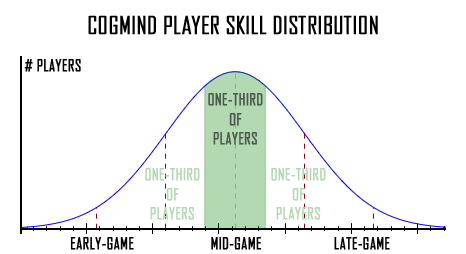
Cogmind player skill distribution: This is an idealized curve, though the actual curve based on reported score data actually looks more or less like this.
Thus assuming the normal difficulty, probably half of players will likely struggle to best the mid-game. While that’s the end result, the true target of (most) well-designed roguelikes should be focused on being winnable nearly 100% of the time by an experienced and skilled player. Remember this does not equate with everyone actually being able to win--some people have gone decades playing, and enjoying, the same roguelike without ever actually winning!
Still, I’ve decided that we need these settings so let’s get into the details of what that actually means.
“Easier Modes”
Cogmind has three difficulty settings: the default, an easier mode, and an even easier mode. I prefer to call them “easier” modes as opposed to “easy” because they are purely relative to the default difficulty, and may very well still be difficult for certain players! (I admit this is somewhat pedantic given everyone’s clear understanding of video game difficulties :P)
The mode can be changed via the options menu, and does not take effect until the next run. I.e. switching to another difficulty mid-run is not allowed. This is for score sheet consistency, so it’s possible to clearly define a run as belonging to one mode or another. Because obviously we’ll want to keep runs separate on the new leaderboards:
Players appear only on the board of the mode for which they most recently submitted a run (older runs are of course remembered for those who switch back and forth). It will be pretty interesting to see what kind of distribution we end up with starting with the next release!
As for the meaning of these modes, adjustments go beyond simple changes in number values, because numbers alone wouldn’t be enough to make the game easier while retaining some semblance of balance and fun.
Easier Mode: The purpose of this mode is to retain most of the challenge and content of the default, still requiring a fair amount of experience and persistence to win, though not quite as demanding as the default mode. It is more for those who would still want to improve and hope to tackle the default mode later.
- 20% base resistance to all damage types
- +5% base accuracy (both ranged and melee)
- Effect of allies on alert level halved
- Disabling machines has less of an impact on alert level
- Traveling to a new area/map lowers alert level more than usual
As you can see, much of this is aimed at reducing the influence of alert level, which presents one of the larger long-term dangers to players who are frequently in combat. And the free damage reduction will somewhat slow the rate of item attrition, the other major factor contributing to Cogmind’s downfall.
Easiest Mode: This mode is quite easy, generally too easy, though yes it’s still possible to lose, and especially certain areas of the world are going to be pretty dangerous! That said, it will be easier to avoid them with minimal experience since the destination of every exit is automatically known in advance. It basically suits those looking for pure entertainment or those without much free time.
- 35% base resistance to all damage types
- +5% base accuracy (both ranged and melee)
- Effect of allies on alert level cut to one-third
- Disabling machines has a much lower impact on alert level
- Traveling to a new area/map lowers alert level much more than usual
- Lower chance of random hostile encounters (most notably in mines/caves)
- Hostile branch encounters (e.g. in caves/mines) cannot appear directly in spawn area
- -1 to all patrol squad sizes (stacks with garrison effect)
- -1 to number of garrisons per floor (cannot reduce to 0, however)
- Exit destinations automatically revealed on sight
- Evolve 1 extra slot on exiting scrapyard
- Scrapyard contains random useful utilities
- Items nearby your spawn in main complex maps replaced by random items more likely to be useful given your current state
All effects are subject to change, but as is there are too many variables and I’m not the target for these features (unlike the default mode!), so to determine how effective they are I’ll have to rely on outside feedback from those who actually need and/or want these modes.
I’ve added a tutorial message that shows after the player’s 5th death (if they are still using the default mode), to let them know there are easier modes if that’s their thing.
For those already using other modes, I’ve added a number of indicators to help both themselves and other players distinguish the setting. First of all, score sheets are now clearly topped with a different header for each mode:
And to help players posting and looking at screenshots discern which mode is being used (it would get really annoying to have to say/ask every time!), the two primary views we’ll see images of now also have highlight color changes to reflect the mode.
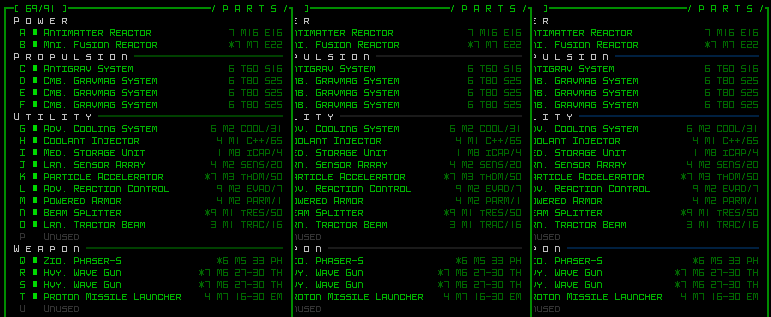
HUD parts list, with a very subtle divider color change (to avoid having a significant impact on the aesthetics).
Hard Mode?
Interestingly, often times when I’ve brought up the idea of difficulty levels someone will ask if there will be harder modes. The fact that this is asked with regularity, despite many players barely being able to survive through the first half of the game, again reflects how valuable varying difficulty levels can be!
For the reason mentioned before--default roguelike mode should be hard--I don’t currently plan to add an explicitly across-the-board harder mode. Instead I’ve taken other approaches to the idea of even more challenging options for experts.
Structurally speaking, the world already has more difficult optional routes and challenges built into it. Some of these are not even known to non-expert players, but are possibilities gradually discovered over time while uncovering more of the lore and NPC encounters. Some involve plot events, and others involve visiting certain areas in a certain order, taking advantage of the non-linear structure of the world to create a multitude of options. Even close to the surface, there are “extended end game” options for the brave or well-equipped.
On another level, strategy-wise winning with different builds also provides its own challenges (akin to winning other roguelikes with a different race or class), some of which are much more difficult than others.
Also falling under the “hard mode” end of the difficulty spectrum, as of the next release Cogmind includes a new framework for “Challenge Modes.” In a sense, these are essentially what are called “conducts” in roguelike tradition, playing the base game albeit while applying some additional rule or rules. Here, however, they are formalized rather than player-enforced.
These rules are more interesting than outright making the game more difficult by changing numbers around, because all the latter suggests is that the player is aiming for highly efficient/optimized play (plus maybe some luck), whereas challenge modes actually fundamentally change the way the game is played! Much more interesting :)
So far I’ve implemented two such modes, mainly as a test, with many more to come, I’m sure. The first is named “Unstable Evolution,” where you no longer have control over which slots you evolve--they are selected at random.
The first there actually looks to be a fairly normal composition, although of course the order could be odd--not evolving what you need when you need it, forcing you to adapt; the second is kinda crazy due to that large number of power slots! This mode should lead to some interesting runs, and enable more types of replayability. (Note that selection is weighted towards what players most often want--e.g. not a ton of power slots, so it’s not necessarily that terrible, but you could get unlucky and have to deal with it… Adapt or die, such is evolution!)
The other new mode is named “Scavenger,” wherein there are no part stockpiles and any solo randomly available items are damaged--everything else must be taken from other robots, or stolen from haulers! (Fabrication would be another option, but that has its own limits.)
You earn points for each challenge applied, and can pick more than one (unless one or more are for some reason incompatible with each other).
With only two modes, for now they are activated directly in the config file, but a new submenu will be added to the in-game options menu once there are enough of them to establish how that submenu will function. There is a forum thread where anyone can drop Challenge Mode suggestions/ideas that I can draw from later.
“Achievements” (as in Steam achievements, but I would want to implement them for non-Steam players as well) will also be a thing, and are similar in nature to difficulty modes, providing alternative goals that might be challenging or just fun. There’s a forum thread to drop those, too :D
Update 190917: Difficulty modes in Cogmind have been rebranded, among other changes based on what I’ve learned from watching the player base over the years.
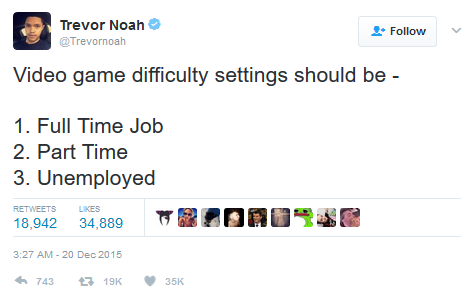
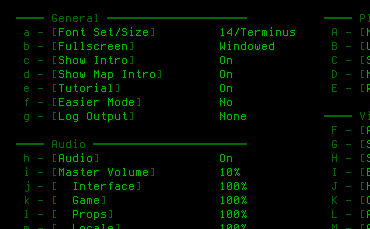
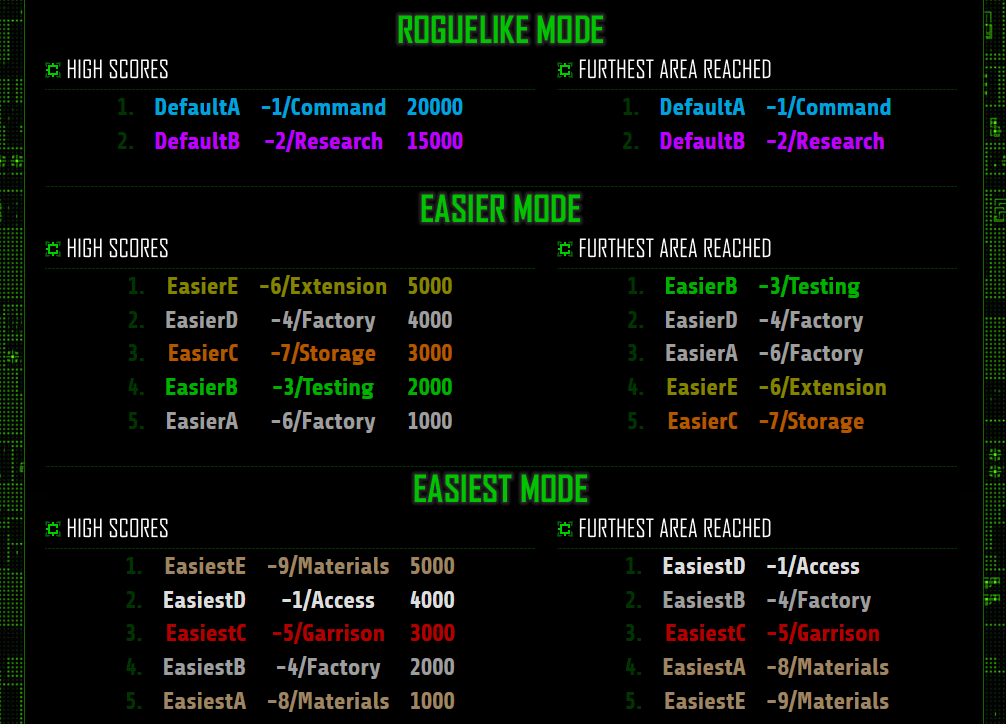
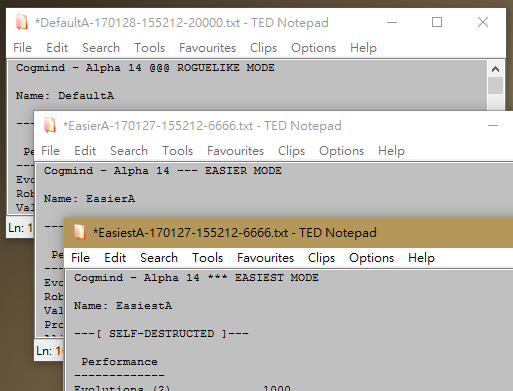
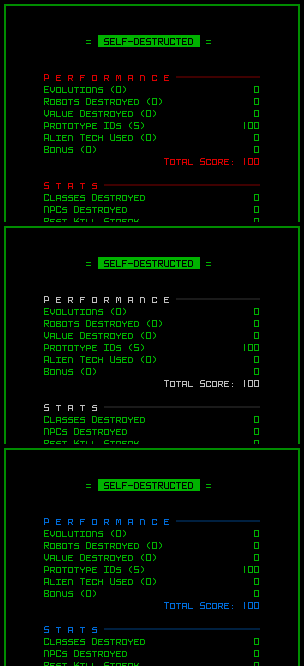
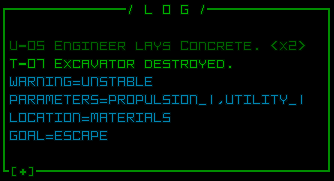
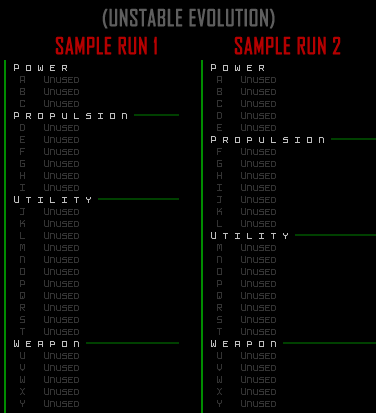
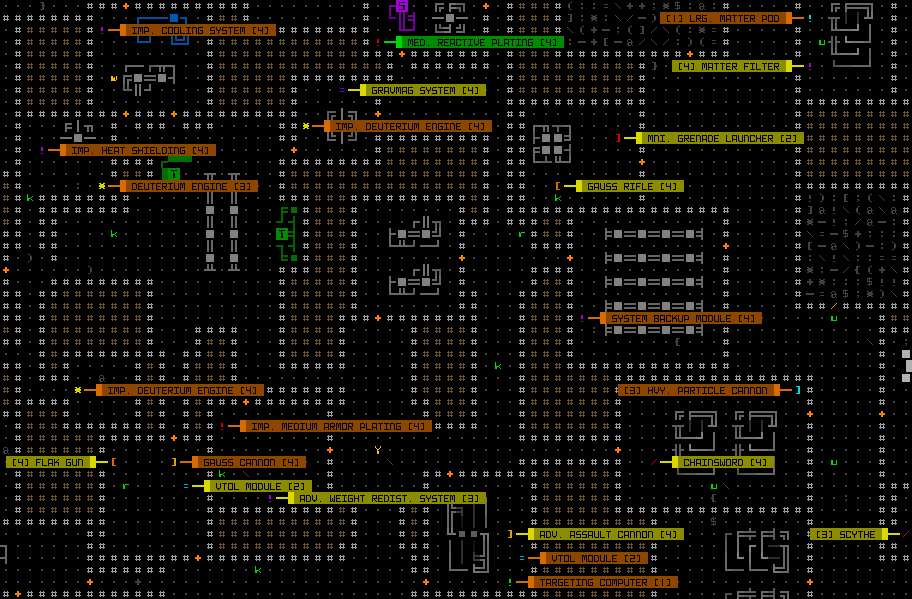
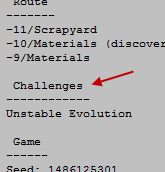



10 Comments
Difficulty levels are always a touchy subject. Some people say everyone should be able to win, others say winning is not a birthright. In my eyes, difficulty levels are fine, but with a caveat -- The difficulty levels should actually provide a difference to the game beyond just the difficulty.
As is said, I don’t think anybody enjoys “It’s exactly the same but numbers are higher/lower” as a difficulty modifier. I think Cogmind is in a relatively unique place for adjusting difficulty due to all the systems it has going on, but I think most games can be worked with to increase/decrease the difference between difficulty levels in a meaningful way. For instance, players below a given difficulty level might not be able to access certain branches. Some of the more potent enemies might not show up, but neither will some of the most powerful weapons. Advanced stuff like Trojans might also not occur below a particular difficulty threshold.
Now, I’ve had this conversation before, and I’ve had people say that this is unfairly punishing people who don’t want to play on a harder difficulty by making them not get the full experience. I argue, however, that there are two Pretty Big benefits to this :
a) By removing some more difficult hurdles, you’re making the easier difficulties… easier. Having to deal with less difficult enemies and at a lower frequency offsets the need to do things like giving the player buffs to compensate, thus not teaching them bad lessons about how to play the game. I would also say that they’re not really “losing out” on anything, as they’re still getting to go through the main game, and this also leads into my second point --
b) In my experience, most people who play a roguelike to completion on easier difficulties tend to stick around and play higher difficulties afterwards, treating the easier difficulty as a “learning mode” before delving into the higher levels. By making certain elements only appear at higher difficulty levels, that preciously limited sense of discovery can actually be applied a little more effectively, as well as making that step up from an easier difficulty level that much more exciting of a prospect. Roguelikes already being designed for replayability, I think this complements that design rather well.
The only people who “lose out” in this scenario are those mentioned early on in the article, the people who argue that a paying customer deserves to receive every single piece of content in the game because they are a paying customer. I’m not really sure if it’s possible to please everyone, though. Wizard mode, maybe?
Yeah it’s impossible to please everyone regardless of what direction is taken (and not just with regard to difficulty settings--that principle applies to everything!). For the reasons you mention I like the idea of gating some content based on difficulty, though that approach requires a lot more work than what I’ve done so far, and can easily destabilize the experience due to (as you point out) Cogmind’s many interconnected systems.
I’ve never added difficulty levels to a game before, so for now we’ll see how this works out in Alpha 14. Myself and the other experienced players aren’t really in a good position to judge what works best here--I’ll need feedback from those players who are new or less skilled, and decide whether there is any reason to make further adjustments.
Wizard mode is certainly another option for learning, though something I don’t want to implement for Cogmind at this time. The situation can change, however, as the community evolves and the game reaches even later stages of maturity.
Heh, I like that Full Time / Part Time / Unemployed tweet. I’ve thought about it in the past regarding RPGs, modifying difficulty via the player’s starting stats, skills, etc.
If you are the Player/God and the character is your agent (instead of being “you” or “your avatar”); difficulty level is how capable your agent is: Easy is when he is a godlike genius himself good at everything (lots of extra points for stats, skills, starting equipment, etc.), and hard is when he’s a drooling moron with no stats at all. So any noob player/god can win with a genius agent character, but it takes a skilled player/god indeed who can take a brainless idiot through to a win.
—
And back to roguelikes, I love them but am not a hardcore player. I’d love an easy mode where the game auto-saves and is restorable at death back at points like: last stairs up/down used, last doorway(s) crossed, etc. It’s anathema to the hardcore players, but it sure makes modern games more fun to treat them like puzzles “nope, that didn’t work, try something else” or “theory was good but failed at execution, try again” and not even having to manage save files. And I loved the way Prince of Persia: Sands of Time handled it in a platformer.
But this is not a suggestion request for Cogmind, just a general observation about what I find fun in games! :)
Anathema, indeed :)
Of course even with Cogmind, players determined to do so can technically cheat to save wherever they want, though I wouldn’t want to add an actual feature like checkpoint-based restorable saves as I believe they distort the intended experience too much, even for non-hardcore players. (Not that you suggested it--just commenting since you brought it up!)
Yes, an easy-restore autosave game like that might be ASCII RPG, but it probably couldn’t be called Roguelike.
It’s funny, because I generally despise ‘checkpoint’ based games because the “just got to get across the next line” mechanic, but I love if the game handles a layered save for me. Back in the day, I developed the habit of multiple saves (not least because games crashed regularily, happily those days are gone…), like one in the world level (inn?), one when I entered a dungeon, and rotating two “progress” saves through the dungeon. I was bitten too often by a save in an unwinnable place (unnoticed lich breathing down my neck), or corrupted around a crash.
But as you say, “intended experience”. Game is balanced one way, breaks to impose another. But alternately, there is always what the dev (or movie director, or author) thinks is the point or fun part, and the different thing the consumer thinks and actually buys the game for or has fun spending their time doing. I think that is where the crafting mechanic came from -- so many crazy players spending time doing that little part of the game that devs barely cared about at first.
To extend this topic, I’ve started a discussion on the forums about considering alternative naming schemes for the modes, which is mostly about affecting perception.
Inspirational post about game difficulty; I think you’ve just about nailed the nuance here.
I would add one more thing -- I personally have played DoomRL on ITYTD (easiest) to start, and eventually stopped at HNTR (2nd easiest) because at that point I felt like I had the “hang” of the game. The higher difficulties were too much of an initial shock and turned me off. It wasn’t until I learned about secrets that were only available on higher difficulties that I was inspired to push through it. I am glad I did! The game’s depth really opened itself up to me and it became much more enjoyable as a result.
> secrets that were only available on higher difficulties
Thanks for bringing that up… A similar comment was made during relevant discussions over on Bay 12, and I should probably take this into serious consideration.
There’s the whole idea that some players will believe it unfair they can’t access certain content, but I like the idea of providing at least some incentives to improve beyond simply “I can claim I’m better now,” especially since Cogmind has so much story and lore behind it to spare. Not to mention, even as is some of that content may be too difficult for those players who need easier modes to reach, anyway, simply due to the nature of the game and its mechanics So blocking it off kinda serves multiple purposes. Hm…
I think variable difficulty settings is probably a good idea on the basis that roguelikes are very challenging information systems to decipher.
I imagine the best players are very methodical and analytical in working out the numbers behind choices and building their “learning tree” of the game system over time?
Whereas I imagine a lot of casual players play and try to improve based on what they sense. Given the information is so fine grain in roguelikes, this leads to requiring lots of runs to develop the experience. I suspect that’s where casuals who want entertainment are catered for: Less runs because less learning tree growth required (ie less information system mastery) and more leniency on basic sensing what to do to progress?
I do think the real fun of the roguelike is the degree of that learning tree found from mastering the skills needed in the game? The main thing is to make the ability to FEEDBACK information clearly so players are able to LEARN effectively (not easily but clearly when they make mistakes or try new options). For example the formulas for a lot of the numbers used in the various interactions are evidently fairly complex.
The other useful thing I’m guessing is allowing flexibility of approach so that trying different approaches is itself fun. I think cogmind adding various builds that work in different ways (combat, speed, hacking, stealth, melee) is allowing different interactions which is fun to experience with which then feels like a form of progress (that learning tree grows some big branches).
Sounds like a good rundown.
Feedback for learning is something I always take into account in the design, but there are also a number of areas which are intentionally more difficult to decipher, requiring that players piece together the relationships between multiple different interactive systems.
Easier modes probably make that aspect easier to deal with, being lenient enough that for simple survival there’s less of a need to figure out the more esoteric mechanics inherent in a system where the world is responding to your presence no a macro scale (something not really done in other roguelikes). Or simply by providing more breathing space in which to explore those relationships.
In any case, we’ll see how effective it is later on. So far there aren’t enough players reporting back about easier difficulties (it’ll probably take Steam levels of players, and an influx of beginners, before we can draw any conclusions). Right now the majority stick to the default mode :)